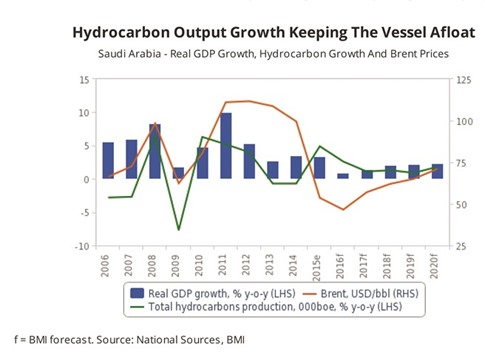Relatively elevated growth in the hydrocarbon sector will prevent the Saudi economy from entering a recession in 2016, BMI Research has said in a report.
Nonetheless, the non-oil economy will continue to post negative growth rates over the coming quarters, as the Saudi government pushes ahead with fiscal retrenchment on the back of low oil prices.
The Fitch Group company said it believes that the Saudi economy will escape entering a recession in 2016 only due to relatively elevated growth in the hydrocarbon sector. The non-oil economy will continue to post negative growth rates over the coming quarters, with ongoing fiscal retrenchment impacting companies’ earnings, business and consumer confidence, and liquidity.
Saudi Arabia’s economic performance has been dependent on the hydrocarbon sector for more than half a century. Oil production accounts for close to 40% of GDP, and the non-oil economy relies on government spending funded by large oil revenues. “In 2016, we forecast real growth in the hydrocarbon sector to reach 2.6% in Saudi Arabia, as the government pushes ahead with its strategy to protect market share over prices,” BMI said.
In Q1, 2016, hydrocarbon production growth came in at 5%.
Saudi production capacity increased by 250,000 barrels a day in May 2016, following the completion of the expansion of the Shaybah oilfield. The projected 2.6% real increase in hydrocarbon output will enable Saudi real GDP growth to remain positive in 2016. “We project that the non-oil economy will remain in recession over 2016, as fiscal retrenchment continues to impact economic activity. Saudi Arabia’s non-oil real economic growth turned negative in Q415 (at -0.5% y-o-y) and remained in negative territory in Q116 (at -0.7% y-o-y). We see little space for improvement over the coming quarters, given that the Saudi government will push ahead with austerity amid low oil prices. We forecast Brent to average $46.5/b in 2016 and $57/b in 2017, well below the $99.5/b recorded in 2014,” BMI said.
In Q415 and Q116, real growth in government spending turned negative (at respectively -8.5% y-o-y and -2.6% y-o-y), dragging on headline growth. The reduction in public spending is also impacting non-oil private sector growth. In March, the Saudi government reportedly instructed ministries to reduce spending by not less than 5% over 2016, a measure that will impact investment, hiring and revenues in the non-oil private sector.
Non-oil private sector economic growth slowed to 0.2% in Q116, with several companies — in particular in the construction sector — facing delays in payments from the Saudi government. Recent data points to business confidence and economic activity deteriorating over the first half of 2016. PMI readings in H116 remained close to their record low of January 2016. In addition, point of sales transaction growth turned negative in Q1, 2016, for the first time in more than a decade, while consumer loan growth has been slowing.
“Given our view that oil prices will remain low over the coming quarters, we do not see the Saudi government slowing the pace of fiscal consolidation. As a result, pressures on the non-oil private sector will remain elevated.
“We expect the Saudi banking sector to continue facing major headwinds over the coming quarters, resulting in tougher conditions for borrowers, even as their margins are coming under pressure from the slowdown. Liquidity will continue tightening: deposit growth turned negative in March 2016 (and has remained so since), while the three-month Saudi Interbank Offered Rate reached 2.6% in July 2016, compared to 0.8% a year earlier,” BMI said.
In February, Saudi Arabia Monetary Agency (Sama) increased the cap on the maximum loan-to-deposit ratio allowed to 90%, compared to 85% previously. We believe that Sama could again raise the ratio cap, given that the sector’s loan-to-deposit ratio is already above this requirement. “We also expect commercial banks to become more prudent in their lending strategies, increasing risk premiums for non-oil private sector companies that are looking to borrow (and in particular SMEs which account for 15% of GDP). We estimate that the non-oil private sector accounts for close to 95% of bank credits in Saudi Arabia,” BMI said.
With the non-oil economy having entered a recession, we believe that the share of non-performing loans in the banking sector will increase, impacting banks’ margins. As a result, Saudi commercial banks will diversify to less risky assets, at a time when the Saudi government is issuing debt to cover large budget deficits. Private sector companies will therefore face increasing difficulties in accessing funding, BMI said.

.


